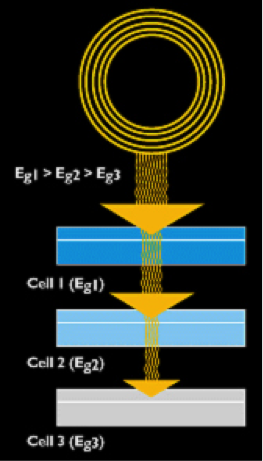5.3. Advanced materials for CPV
Traditional PV systems use a large amount of silicon; in contrast, CPV systems use a small amounts of high‐efficiency PV materials. A typical example of such high-efficiency cells employed in high concentration CPV systems is a multijunction cell. The term multijunction refers to the cell structure, which has multiple p-n junctions combined within a single cell. Each junction is responsible for absorbing light within a particular wavelength range. All the junction currents are then combined to one output.
Combination of multiple p-n junctions within one cell is achieved by blending several semiconductor materials in layers or in other heterostructural formations. Manufacturing those formations can be tricky, and therefore costly. However, the pay-off on the efficiency side of the technology proves to be worthy. While single junction PV cells have the maximum theoretical efficiency around 34%, multiple junction cells can achieve in ideal case the limiting efficiency of 86.8% under concentrated sunlight (Wikipedia, Multijunction PV cell).
Consider the two single junction cases below (high band gap and low band gap) (Figure 5.3.1 and 5.3.2).
.png)
.png)
Figures 5.3.1 & 5.3.2 show two scenarios that illustrate the use of low band gap (top) and high band gap (bottom) materials. They both have limitations, which are responsible for low efficiency of single-junction PV cells. This is why tuning the different bandgaps to different components of light is a good idea in terms of minimizing power losses. Specific disadvantage of each scenario is stated under the plots. Combining different materials with different band gaps allows the cell to absorb a wide range of wavelengths and thereby to reach the highest efficiency.
To combine different materials in the multijunction cell, certain requirements need to be met for lattice-matching, current matching, and providing high opto-electronic performance. Regarding the first requirement of lattice-matching, one needs to make sure that the lattice constants of materials included are close. If the mismatch is significant, intercrystal defects can lead to quick degradation of electronic properties. For current matching, ordering of semiconductor layers within the multijunction cell is done in such a way that high-bandgap materials are placed on the top of the "sandwich," while the low-bandgap materials are placed on the bottom (Figure 5.4). That allows the light with low energy (greater wave lengths) to transmit to the lower layers and to be usefully absorbed. This concept is demonstrated in Figure 5.4. In this design, the suitable bandgaps need to be chosen so that the currents generated at each p-n junction are matched. If, for example, one of the junctions produces much lower current, it will be detrimental to the total current of the cell (because the layers are connected in series).

Check Your Understanding - Question 3 (Essay)
The configuration of layers shown in Figure 5.4 is logical in order to allow the maximum amount of light to be absorbed. What would happen if we accidentally put Cell 3 on top of the "sandwich"? Explain, then click for answer.
Next, we will refer to the following review on multijunction cell materials, their materials and design.
Reading Assignment
Journal Article: Cotal H. et al., III-V multijunction solar cells for concentrating photovoltaics, Energy Environ. Sci., 2009, 2, 174–192.
Reading this article, note the basic principles of operation of multijunction cells and define the key parameters that are responsible for their high efficiency. The reading quiz in this lesson is largely based on this material.
Reading Quiz
Now it would be the best time to take the Reading Quiz. Go to Canvas Module 5 to complete the assignment.
